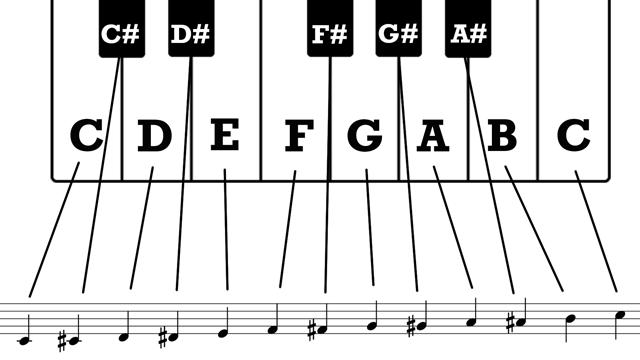Introduction to the Chromatic Scale
They called it noise, chaos even. But for me, the chromatic scale was the unsung hero of every electrifying solo I’d ever heard. It was a revelation in my journey as a guitarist—a simple yet profound shift that liberated my playing and opened doors to endless creativity. Yet, many still overlook its power, unaware of its transformative potential. Could mastering this elusive scale be the key to your musical breakthrough?
As a guitarist and music theorist, I’ve come to appreciate how pivotal the chromatic scale is for developing both technical finesse and musical improvisation. Understanding music theory, particularly the foundations laid by various guitar scales, can elevate your playing to new heights. In this guide, I’ll detail the scale’s intricacies, share practical exercises, and illustrate seamless integration into your improvisational skills. Whether you’re tuning your first strings or a seasoned player, this journey promises transformative insights.
What is the Chromatic Scale?

Having taught and studied various scales extensively, I can attest that the chromatic scale is crucial for both beginners and seasoned musicians to navigate the fretboard. At its core, the chromatic scale spans all 12 pitches found in Western music, forming a continuous chain of semitones. Each note is a half step apart, creating the 12-tone scale that is the foundation for much of our musical exploration and expression.
The chromatic scale is more than just a series of notes; it’s the backbone of modern music theory. It allows musicians to understand the relationship between different pitches and serves as a fundamental tool for creating tension and resolving it in compositions. This scale isn’t just about moving one fret at a time—it’s about developing precision, timing, and a deeper understanding of musical intricacies that transcend basic melodies.
Through my years of teaching, I’ve observed how mastering the chromatic scale enhances a guitarist’s ability to improvise and enriches their overall playing technique. When you become familiar with all 12 notes, you open the door to endless musical possibilities, allowing you to experiment with new sounds and find your unique style on the guitar.
Why Learn the Chromatic Scale?

Learning the chromatic scale can drastically improve your improvisation skills—are you ready to take your playing to the next level? In my journey as a guitarist, I’ve worked with many students ranging from beginners to seasoned musicians, and one truth consistently emerges: the chromatic scale is a powerful tool for elevating your guitar technique and overall musical prowess.
Incorporating the chromatic scale into your practice routine brings a multitude of benefits. It not only enhances your *finger dexterity* and *speed* but also provides a foundation for understanding **musical theory**, helping you develop a more nuanced ear for melodies and harmonies. The beauty of the chromatic scale lies in its simplicity—all twelve notes within an octave are at your disposal, offering infinite possibilities for creativity and expression.
From my perspective, the chromatic scale acts as a bridge to more complex improvisational paths. By practicing it diligently, you can transition more fluidly between keys and *improvise* with confidence. You begin to hear those subtle notes that dance between the conventional scales, adding color and emotion to your solos. For guitarists aspiring to break free from the constraints of basic scales, the chromatic scale serves as a gateway to innovative playing.
Embracing this scale goes beyond technical improvement; it reshapes how you perceive and interact with music. So, are you prepared to discover new layers of expression in your playing and truly master your instrument? Let’s delve deeper into how to effectively play the chromatic scale on the guitar.
How to Play the Chromatic Scale on Guitar
Basic Chromatic Scale Fingerings

What if the key to unlocking fluidity in your guitar playing lies in mastering basic fingerings? From my experience in teaching guitar, I can assure you that the right fingerings can set a strong foundation for more complex techniques. When playing the chromatic scale, having a clear understanding of basic fingerings is crucial. It not only enhances your dexterity but also improves your ability to smoothly transition between notes.
In the context of guitar scales, utilizing the correct fingerings allows for efficient movement along the fretboard. By familiarizing yourself with the sequential note patterns, you can minimize unnecessary movement, which is key to maintaining fluidity and speed in your playing. This section will guide you through essential finger placements, helping you play with confidence and precision. As you progress through this guide, you’ll find that these foundational techniques are indispensable stepping stones to mastering the chromatic scale’s intricacies. Let’s dive in and solidify that base before exploring chromatic scale patterns across the fretboard in the next section.
Chromatic Scale Patterns Across the Fretboard

Did you know that exploring various patterns across the fretboard can reveal new creative elements in your playing? As we delve into chromatic scale patterns, we uncover a wealth of possibilities that can transform your guitar skills. Drawing on my background in contemporary improvisation, I encourage students to embrace these patterns as a means to broaden their musical vocabulary.
When navigating the frets on guitar, understanding these various chromatic scale patterns offers a significant advantage. By moving beyond standard positions, you gain flexibility and freedom in your movement across the fretboard. This not only aids in mastering the chromatic scale itself but also serves as a bridge to innovative improvisation techniques.
Let’s explore how to map these patterns across the neck. Begin by recognizing that a chromatic scale comprises all twelve distinct pitches within an octave. As you chart these notes on the fretboard, experiment with transitioning between traditional and unconventional fingerings. This practice helps in internalizing the scale across different keys, facilitating fluid and seamless playing.
By integrating these techniques into your routine, the fretboard transforms into a landscape ripe for exploration, revealing not only technical precision but also *artistic expression*. As we move forward, keep these insights in mind as they are pivotal for advancing through the upcoming sections of this guide.
Practical Exercises for the Chromatic Scale
Warm-up Exercises

Could a few minutes of warm-up exercises be the secret to unlocking greater dexterity on the guitar? I’ve found that *warm-up exercises are not just a routine; they are essential*. They lay the groundwork for executing more *demanding techniques*. In my teaching, I emphasize these exercises because they help prepare both the hands and mind, creating the right conditions for a productive practice session.
Before diving into more complex chromatic scale exercises, it’s crucial to engage muscles through systematic warm-ups. This not only prevents injury but also enhances *fluidity and speed*. Start with simple finger stretches and progress to consistent picking patterns. These activities, while appearing simple, directly contribute to the fluid motion and accurate finger placements required for chromatic precision.
Moreover, integrating these warm-up exercises with chromatic scale workouts reinforces mastery. Here’s one of my top guitar practice tips: incorporate broad and narrow hand movements to cover different parts of the fretboard. This ensures the agility needed when tackling advanced techniques, setting the stage for future sections like ‘Integrating the Chromatic Scale into Your Playing’. Ultimately, these *foundational steps* lead to *effortless improvisation*, making it a vital part of mastering the chromatic scale on guitar.
Advanced Chromatic Techniques

In my editorial work, I’ve explored many advanced techniques that integrate the chromatic scale, which can lead to truly innovative and expressive playing. How do advanced techniques with the chromatic scale set seasoned players apart in their musical expression? The answer lies in the richness and complexity these techniques can add to one’s repertoire. A deep dive into advanced chromatic techniques reveals their potential for improving guitar technique, transforming simple scale exercises into powerful tools for artistic growth.
Within the spectrum of guitar lessons, these advanced exercises focus on precision, speed, and fluidity. For instance, employing varied picking methods and finger positions unlocks a multitude of tonal colors. It’s not merely about dexterity; it’s about forging a personal signature through nuanced expression. By mastering these techniques, players can embellish their soloing and rhythm work, making their sound more dynamic and engaging.
Transitioning smoothly from basic warm-ups to complex scales, you elevate your practice from rudimentary to revolutionary. Integrating these sophisticated techniques sets a foundation for crafting unique musical stories and prepares you for seamlessly integrating the chromatic scale into your improvisation. This approach not only refines your skillset but also enriches your musical vocabulary, paving the way for endless creative possibilities.
Integrating the Chromatic Scale into Your Playing
Improvisation with the Chromatic Scale

Why do so many great improvisers credit the chromatic scale as their secret weapon? As an editor, I’ve learned that improvisation is an art form greatly enhanced by the confidence that comes from mastering scales, especially the chromatic scale. This unassuming sequence of notes holds the power to add depth and fluidity to your solos, transforming them from predictable to extraordinary.
When we talk about guitar scales, the chromatic scale often gets overshadowed by its more intricate cousins. However, understanding and integrating it can drastically improve your guitar technique. It allows you to smoothly transition across the fretboard, creating seamless connections between musical ideas. By subtly weaving chromatic notes into your licks, you introduce tension and release that keep your audience captivated.
The real magic happens when you start to experiment with these transient tones during improvisation. The chromatic scale enables dynamic expression, readily adapting to jazz, rock, or blues genres, making your playing sound simultaneously polished and spontaneous. This section delves into strategies for incorporating the chromatic scale into your improvisational toolkit, building on the foundation laid in the previous chapter to further elevate your musicality.
FAQs
What is a chromatic scale on the guitar?
Why is mastering the chromatic scale important for guitarists?
How do I practice the chromatic scale effectively on the guitar?
What exercises can help with mastering the chromatic scale?
How does understanding the chromatic scale aid in improvisation?
Conclusion
Reflecting on my journey as a musician and educator, the chromatic scale offers endless opportunities for growth and exploration in every guitarist’s playing. Is the chromatic scale key to breaking through your musical barriers and expanding your skills? Exploring its vast potential can significantly enhance your *improving guitar technique*, fostering a deeper understanding of *guitar scales*.
From mastering the basic fingerings to discovering advanced techniques, the chromatic scale isn’t just a tool—it’s a roadmap to creativity. By integrating these elements into your practice, you’ll unlock new dimensions in your musical repertoire, leading to both technical mastery and personal expression.

